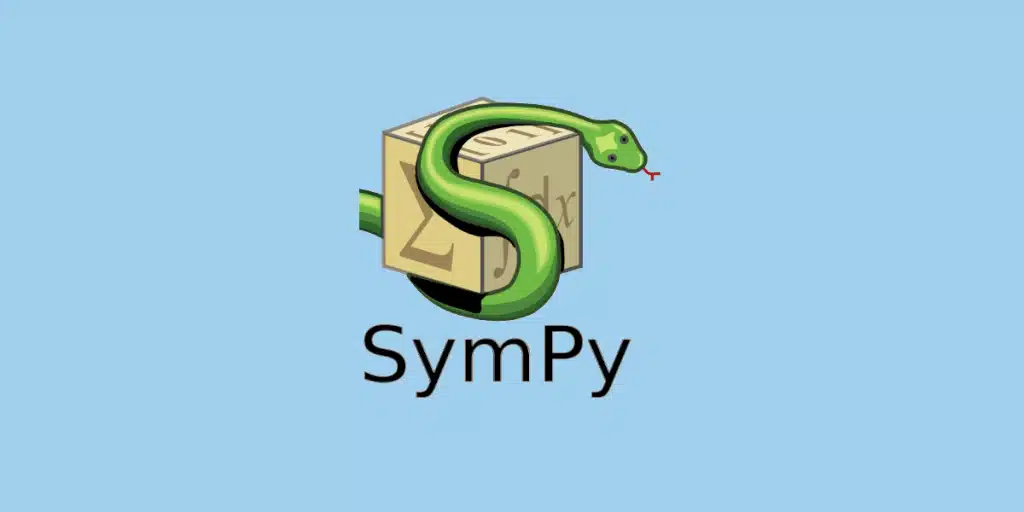SymPy is a Python library dedicated to symbolic mathematics. Find out all you need to know about this useful tool for Data Science!
Mathematics is essential in Data Science. Fortunately, there are many Python libraries dedicated to this discipline, such as NumPy, SciPy, Scikit-Learn and TensorFlow.
When it comes to mathematical symbols, the most popular Python library is SymPy. Its name stands for “Symbolic Mathematics in Python”, and it is part of the SciPy ecosystem alongside NumPy, Pandas and Matplotlib.
💡Related articles:
| Matplotlib: Master Data Visualization in Python |
| Python Crash Course: Get started |
| Mastering Machine Learning in Python: Data-Driven Success |
| Python Programming for Beginners – Episode 3 |
What is SymPy?
The SymPy library for Python presents itself as a complete computer algebra system (CAS), while keeping the code simple so that it can be understood and expanded.
Written entirely in Python, it is simple to use, relying solely on mpmath: a pure Python library for floating-point arithmetic.
Focused on simplicity and extensibility, it makes no attempt to extend the Python language. Its aim is to enable users to use it alongside other libraries within an interactive environment, or as a component of a larger system.
It can be incorporated into other programs, and modified with custom functions. This library is offered free of charge under the BSD license.
How do I use SymPy?
SymPy is easily installed using the “pip install sympy” command. The fundamental object of this library is the symbol.
After importing the sympy package as “sp”, create a symbol “x” representing an unknown value with the command “x = sp.symbole(“x”)”. Several symbols can be created, such as “x” and “y”, depending on the number of unknowns. These symbols can be added, subtracted, multiplied and divided as required.
There are numerous SymPy functions. For example, sympify() transforms an arbitrary expression into a SymPy expression and converts standard Python objects.
For its part, the evalf() function evaluates a specific numerical expression to a maximum precision of 100 decimal places. It can accept a dictionary object with numerical values as a sub-argument.
The Lambdify() function converts expressions into Python functions. Indeed, the evalf() method is inefficient for evaluating an expression over a wide range of values.
Lambdify works in a similar way to a lambda function, but translates SymPy names into the names of the specified numerical library. This is usually NumPy.
Functions can be written in the script text, in the terminal or on a Jupyter notebook. This provides a graphical representation of the calculations.
Alternatives to SymPy
Many of the Computer Algebra System (CAS) tools available as alternatives to SymPy are closed-source. This can make it difficult to understand how a result is obtained, and such software is generally expensive.
One of the best-known examples is Wolfram Mathematica. There are also free tools, such as the free Desmos calculator.
The best-known Python tools dedicated to mathematics are NumPy and Pandas. However, while NumPy and SymPy are two libraries designed for maths, they are very different. NumPy operates numerically, while SymPy works with symbolic expressions. However, it is possible to export a SymPy expression to a NumPy array using the lambdify function.
Likewise, SciPy offers several functions similar to SymPy, such as equation solving, integration and differentiation. It also offers linear algebra functions similar to NumPy. Unlike SymPy, SciPy is not written entirely in Python. Another notable difference is that mathematical functions are written as simple Python functions returning a result, rather than as mathematical expressions.
In general, SciPy is ideal for integrating high-speed mathematical algorithms into Python. SymPy, on the other hand, is more suited to the needs of a mathematics student, researcher or data scientist.

Another computer algebra system using Python as its programming language is SageMath. It is, however, a much heavier program than SymPy, requiring a download of over a gigabyte.
As well as being compact, SymPy has no dependencies other than Python. It can therefore be used in any environment.
For its part, Sage presents itself as a complete mathematical system, combining all the major open-source systems into a single solution. Using a function invokes the corresponding open-source packages.
This CAS is based on a dedicated language built on top of Python and a set of open-source libraries written in C, Fortran or even LISP.
This is not the case with SymPy, which is an independent system, embedding all its functionalities. What makes SymPy so special is that it is a Python library.
SageMath’s abstraction from Python means it can be used as a general-purpose CAS. SymPy, on the other hand, is more suited to integration into a Python application.
Many CAS designed for use in interactive environments are difficult to automate and extend. This is not the case with SymPy, which can be used interactively on Python or imported into your own program. Its APIs also simplify extension.
Conclusion
SymPy is a powerful library dedicated to symbolic mathematics. It enables you to create variables and functions, as well as extend and simplify mathematical statements symbolically or solve equations.
To learn how to handle Python and the various libraries dedicated to mathematics, you can choose DataScientest training courses. Our various courses include a module dedicated to this programming language.
By following our distance learning courses, you can acquire all the skills you need to work as a Data Analyst, Data Engineer, Data Scientist, Machine Learning Engineer or Data Product Manager.
Our courses can be completed via BootCamp or continuing education, and our state-recognized organization is eligible for funding options Discover DataScientest!










